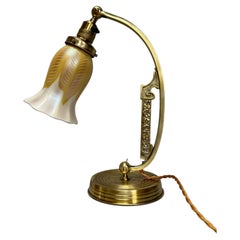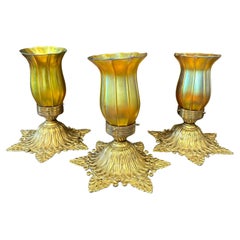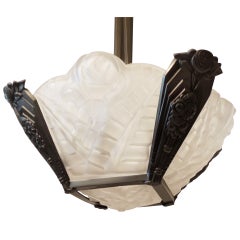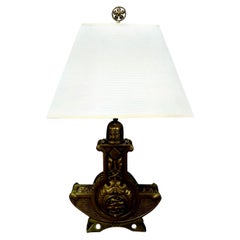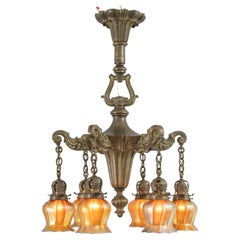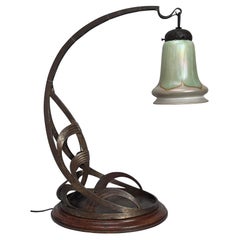Quezal Lighting
to
2
2
4
Height
to
Width
to
3
1
2
1
4
3
1
2
1
1
4
2
1
1
1
2
2
1
1
4
4
4
3
1,434
1,196
1,075
1,072
Creator: Quezal
Quezal Art Nouveau Lamp
By Quezal
Located in NANTES, FR
Art nouveau lamp circa 1910.
Brass and copper base.
Iridescent glass tulip signed Quezal.
In perfect condition and electrified.
Total height: 38.5 cm
Base diameter: 15.5 cm
Width: 30 cm
Quezal Art Glass
Quezal Art Glass – The Journal of Antiques and Collectibles – April 2003
By Malcolm Mac Neil
Some of the most beautiful and alluring art glass made in America during the early part of the 20th Century was made by the Quezal Art Glass and Decorating Company. Often in the shape of blossoming lilies with brilliant gold interiors and colorfully decorated with floral and other motifs inspired by nature, Quezal art glass ranks right alongside the iridescent glass of Louis Comfort Tiffany and Frederick Carder. Quezal artisans created an extensive range of decorative and useful items, including vases, compotes, finger bowls, open salts, candle holders, and shades for lighting fixtures, which are equivalent in terms of beauty and quality of craftsmanship to Tiffany’s Favrile and Carder’s Aurene glass. In recent years, glass collectors have discovered anew the special charms and appeal of Quezal art glass, and collector desirability for this lovely glassware has increased dramatically.
The Quezal Art Glass and Decorating Company was incorporated a century ago, on March 27, 1902. It was founded by Martin Bach, Sr., Thomas Johnson, Nicholas Bach, Lena Scholtz, and Adolph Demuth. The factory was located on the corner of Fresh Pond Road and Metropolitan Avenue in Maspeth, Queens, New York. In October 1902, the trademark “Quezal” was successfully registered. By 1904, roughly fifty glassworkers were employed at the works.
Martin Bach, Sr. was the president, proprietor, and guiding force behind this successful company. Born in 1862 in Alsace-Lorraine to German parents, he emigrated to the United States in 1891. Before his emigration, Bach worked in Saint-Louis, France, at the Saint-Louis Glass Factory. After Bach arrived in this country, he was hired by Louis C. Tiffany as the latter’s first batch-mixer or chemist at the newly established Tiffany Glass and Decorating Company, in Corona, Queens. After a period of about eight years, Bach left Tiffany and established his own glassworks. By this time, Bach had already started his small family. He and his German-born wife, Anne-Marie Geisser, whom he married in the fall of 1889, in Paris, France, had three children. Two daughters, Jennie and Louise, were born in France and a son, Martin, Jr., was born in Corona.
Bach was assisted by Thomas Johnson, an English immigrant, and Maurice Kelly, a native of Corona, both of whom were gaffers or master glassblowers. Johnson and Kelly helped pave the way for Quezal’s early accomplishments and later recognition. Thomas Johnson, like Bach, was a founding member and also previously employed by Louis C. Tiffany. Johnson’s association with Quezal, however, was relatively short lived. Around 1907, Johnson left for Somerville, Massachusetts, where he became involved in making Kew Blas glass, under William S. Blake at the Union Glass Company. Maurice Kelly’s tenure with Quezal was also brief. Kelly worked at Quezal from January 1902 until July 1904, but by November 1904, he was making Favrile glass at Tiffany Furnaces, where he would happily remain until 1918.
To this day, the belief still exists that there once existed a man named Quezal, who worked for Louis C. Tiffany, and it is after him that Quezal glass is named. In truth, however, the founders of the Quezal Art Glass and Decorating Company named the company and its products after one of the world’s most beautiful birds, the elusive and rare quetzal, which dwells in the treetops of the remote tropical forests of Central America. A rare company promotional brochure provides a vivid description of the quetzal: Of all the birds of the America’s, it is the most gorgeous. No more splendid sight is to be seen in all the world than a quezal, flying like a darting flame through the depths of a Central American forest. Its back is of a brilliant metallic green, so vivid it shines even in the twilight of the woods like a great emerald and its breast is a crimson so deep and bright that every motion of the wonderful creature is a flashing of rubies among the trees and giant creepers. It bears a true golden crown upon its head – a helmet of bright yellow and green, shaped just as the helmet of old Aztec kings were shaped. Its tail is composed of lacelike plumes, extending more than two and one-half feet beyond its body.
The quezal was certainly an appropriate designation for the company’s resplendent glassware. One of the most prized characteristics of Quezal art glass is the shimmering and dazzling brilliance reflected in the iridescent surfaces on the interior as well as exterior of the glass. The radiant rainbow colors in metallic hues, including gold, purple, blue, green, and pink, to name only a few, were certainly inspired by the quetzal and its feathers. Not surprisingly, lustrous feathers, in shades of opal, gold, emerald, and blue, are among the most common decorative motifs encountered on Quezal glass.
The enduring hallmark of Quezal art glass is its unique expression of the Art Nouveau style, based on organic shapes and naturalistic motifs coupled with technical perfection in the execution. Vases, compotes, drinking vessels, and shades for lighting fixtures were often fashioned to resemble flowers such as crocuses, tulips, calla lilies, casablanca lilies, and jack-in-the-pulpits. Variously colored inlaid threads of glass, pulled and twisted by hooks, simulate naturalistic floral and leaf patterns, lily pads, clover leafs, and vines. Opal, gold, and green colors prevail and the glass is generally opaque. Red is the rarest color of all. Compared with Tiffany’s Favrile glass, the crisp, vivid, and colorful decoration of Quezal art glass is distinctively precise, symmetrical, and restrained.
Other Quezal wares recall shapes and styles favored in ancient Egypt, Persia, Greece, and Rome, as well as the Italian Renaissance and the Georgian period in England. This is especially true of classic-shaped vases and bowls of translucent amber glass, which have a single surface color such as iridescent gold or blue. Still, others were inspired by traditional Chinese and Japanese forms.
The Gorham Manufacturing Company in Providence, Rhode Island, and the Alvin Silver Manufacturing Company in Sag Harbor, Long Island, purchased Quezal art glass, which they in turn embellished in their shops with silver overlay decoration in the fashionable Art Nouveau style and later resold. Gorham’s silver overlay designs mostly include stylized floral motifs. Alvin’s silver designs are wonderfully organic. One sumptuous design is of a group of sinuous iris blossoms with carefully articulated petals surrounded by attenuated meandering vines. Collectors should note that not all silver-deposit pieces are marked with a maker’s mark since the silversmith had to be quite careful not to damage the glass underneath.
A rare 1907 retail catalog survives from Bailey, Banks, and Biddle Company, a luxury goods retailer in Philadelphia, which reveals original retail prices of Quezal art glass. A surprising revelation provided by this catalog is that Quezal art glass was nearly twice as expensive as comparable French imported glass made by such renowned firms as Gallé and Daum. Hock glasses, a stemmed glass used primarily for drinking German white wine, were sold by the dozen and retailed between $50 and $75. Fingerbowls were also sold by the dozen and retailed between $50 and $100. These high retail prices were nearly the same as those charged for Tiffany’s Favrile glass, and suggest Quezal art glass was also marketed towards the high-end or luxury market.
Electricity was a brand new invention in the late 1800s and American glass manufacturers developed novel approaches for concealing the electric light bulb, which was rather harsh to the eye and perhaps unflattering to the domestic interior. Tiffany, Steuben, and Quezal responded to this need with the most extraordinary and beautiful art-glass shades, all of which were hand-made and exquisitely fashioned. Many other companies also made art glass shades for table and floor lamps, electroliers, hallway fixtures, and wall sconces, but it was Quezal that excelled in this area and was the most prolific.
Quezal art glass shades were available in an infinite variety of shapes, sizes, colors, and decorations. Some shades are formed and decorated as lilies while others are bell-shaped and have ribbed or textured decoration. Rims are usually plain but sometimes are notched or ruffled. Common motifs include feather or hooked feather, leaf and vine, applied flowers, drape, fishnet, King Tut, and spider webbing. The workmanship shown on most Quezal shades...
Category
1910s French Art Nouveau Vintage Quezal Lighting
Materials
Brass, Copper
$3,336
Three Quezal Lampshades
By Quezal
Located in London, GB
Three iridescent firm glass pattern shades.
In good condition. One shade has a minor chip on rim, which would be covered by the cap. See photos, chip on display there.
Other two, go...
Category
1970s American Vintage Quezal Lighting
Materials
Blown Glass
$1,376 / set
1910 Art Nouveau P. Rigual Lily Pad Motif Boudoir Lamp, 13" high, Quezal Shade
By P. Rigual, Quezal
Located in Toledo, OH
This turn of the century art nouveau boudoir lamp by P. Rigual is fitted with a Quezal shade. The bell form iridescent glass shade has gold thr...
Category
1910s Art Nouveau Vintage Quezal Lighting
Materials
Art Glass
Quezal Art Glass Fixtures (3)
By Quezal
Located in Bronx, NY
This interesting group of three vintage bronze flush mount ceiling fixtures dates from the 1920’s. Each sculptured bronze fixture features stylish decoration & holds a beautiful bell...
Category
1920s American Art Deco Vintage Quezal Lighting
Materials
Bronze
Related Items
Wonderful Art Deco Glass and Silvered Bronze Light Fixture Signed Degas
Located in Roslyn, NY
Art Deco glass and silvered bronze fixture signed Degas. Frosted glass is beautifully embossed flowers and leaves.
There are four interior lights.
Category
20th Century French Art Deco Quezal Lighting
Materials
Bronze
$2,650
H 20 in W 12 in D 12 in
Austrian Art Nouveau Bronze Lamp
Located in Houston, TX
Lovely period Austrian Art Nouveau bronze table lamp. This beautifully detailed, high quality Austrian bronze lamp has been newly wired and would w...
Category
1910s Austrian Art Nouveau Vintage Quezal Lighting
Materials
Bronze
Swedish Modern Art Glass Light Fixture
Located in New York, NY
This lovely fixture relies on molded textured glass on the interior surface and wavy carving and a stain on the exterior surface to create the happy, stylized floral pattern. A brass...
Category
1960s Swedish Scandinavian Modern Vintage Quezal Lighting
Materials
Art Glass
Amethyst Glass Light Fixture
Located in New York, NY
A circa 1960 Italian amethyst "jellyfish" light fixture with 2 candelabra lights.
Measurements:
Present drop: 9"
Diameter: 10.5"
Category
1960s Italian Vintage Quezal Lighting
Materials
Bronze
Wonderful French Art Deco Silvered Bronze and Art Glass Flush Mount Fixture
Located in Roslyn, NY
A wonderful French Art Deco silvered bronze and art glass flush mount fixture set with four lights inside.
Category
20th Century French Art Deco Quezal Lighting
Materials
Bronze
$2,950
H 11 in W 16 in D 16 in
Brass and Light Beige Lampshade Three-Light Adjustable Height Pendant Light
Located in Barntrup, DE
Beautiful adjustable height three-light brass pendant lamp with fabric lampshade, Germany, circa 1980.
Made in the Scandinavian Modern style, this impressive pendant light features a...
Category
Late 20th Century German Scandinavian Modern Quezal Lighting
Materials
Metal, Brass
$1,943
H 27.56 in Dm 17.72 in
Art Nouveau Table Lamp, 1910's
Located in Praha, CZ
Beautiful antique Art Nouveau lamp made of copper alloy, patinated to old bronze. Produced in former Czechoslovakia in the very beginning of 2...
Category
Early 20th Century Czech Art Nouveau Quezal Lighting
Materials
Metal
Murano Glass Art Deco Style Glass Disc Fixture
Located in Manhasset, NY
Art Deco style multicolored glass disc fixture with chrome center rod.
Category
1970s Argentine Art Deco Vintage Quezal Lighting
Materials
Glass
Unique Ceramic Table Lamp by Møller & Bøgely, Art Nouveau, Denmark, 1910s
By Møller & Bogely
Located in Odense, DK
Beautiful handmade table lamp made in Denmark between 1910-1920 at "Møller & Bøgely" workshop. The lamp base is made from earthenware and decorated using hand glazing and sgrafitto t...
Category
1910s Danish Art Nouveau Vintage Quezal Lighting
Materials
Earthenware
$3,338
H 23.63 in Dm 14.97 in
Petite Art Nouveau Brass Table Lamp
Located in Grythyttan, SE
This charming petite table lamp embodies the elegance of Art Nouveau design. Crafted from solid brass, the lamp features an intricately cast base with organic, flowing motifs charact...
Category
Early 20th Century Swedish Art Nouveau Quezal Lighting
Materials
Brass
Pair of Art Nouveau Lamps by Denbac, France, C1910
By Denbac
Located in Trensacq, FR
Art Nouveau lamps by Denbac France C1910
A pair of beautiful Art Nouveau lamps from Denbac, France c1910.
Flamed sandstone urns shaped lamp bases with distinguishing drip glazed de...
Category
Early 20th Century French Art Nouveau Quezal Lighting
Materials
Sandstone, Brass
Tiffany Studios Style Antique Art Nouveau Desk Lamp With Quezal Art Glass Shade
By Tiffany Studios
Located in South Bend, IN
A gorgeous antique Art Deco or Art Nouveau period desk lamp or table lamp
In the manner of Tiffany Studios
USA, Circa 1930s
Cast iron base, with brass stem, and beautiful Favrile ...
Category
1930s American Art Nouveau Vintage Quezal Lighting
Materials
Brass
$2,395
H 16 in W 5.5 in D 10.5 in
Previously Available Items
6 Arm Edwardian Bronze Chandelier w/ 6 Signed Quezal Art Glass Shades, ca. 1910
By Quezal
Located in Petaluma, CA
This chandelier is a high quality piece of lighting. Cast in bronze with the original lovely factory patina. Even the ceiling canopy is cast bronze. The hand blown art glass shades a...
Category
1910s American Edwardian Vintage Quezal Lighting
Materials
Bronze
H 29.5 in W 17 in D 17 in
Art Nouveau Table Lamp signed Quezal
By Quezal
Located in NANTES, FR
Large art nouveau lamp circa 1900.
Wrought iron frame mounted on a wooden base.
Glass tulip signed Quezal. Signature stamped on the collar of the tuipe.
Wrought iron frame made by Cherpions establishments, signed on the claw of the tulip "Cherpions Nancy"
Electrified lamp and in perfect state of conservation.
Total height: 49.5 cm - 19.48 in
Base length: 28.5 cm - 11.22 in
Base depth: 23.5 cm - 9.25 in
Weight: 3.5kg
You can contact me for more information and delivery costs.
Quezal
Quezal Art Glass – The Journal of Antiques and Collectibles – April 2003
By Malcolm Mac Neil
Some of the most beautiful and alluring art glass made in America during the early part of the 20th Century was made by the Quezal Art Glass and Decorating Company. Often in the shape of blossoming lilies with brilliant gold interiors and colorfully decorated with floral and other motifs inspired by nature, Quezal art glass ranks right alongside the iridescent glass of Louis Comfort Tiffany and Frederick Carder. Quezal artisans created an extensive range of decorative and useful items, including vases, compotes, finger bowls, open salts, candle holders, and shades for lighting fixtures, which are equivalent in terms of beauty and quality of craftsmanship to Tiffany’s Favrile and Carder’s Aurene glass. In recent years, glass collectors have discovered anew the special charms and appeal of Quezal art glass, and collector desirability for this lovely glassware has increased dramatically.
The Quezal Art Glass and Decorating Company was incorporated a century ago, on March 27, 1902. It was founded by Martin Bach, Sr., Thomas Johnson, Nicholas Bach, Lena Scholtz, and Adolph Demuth. The factory was located on the corner of Fresh Pond Road and Metropolitan Avenue in Maspeth, Queens, New York. In October 1902, the trademark “Quezal” was successfully registered. By 1904, roughly fifty glassworkers were employed at the works.
Born in 1862 in Alsace-Lorraine to German parents, he emigrated to the United States in 1891. Before his emigration, Bach worked in Saint-Louis, France, at the Saint-Louis Glass Factory. After Bach arrived in this country, he was hired by Louis C. Tiffany as the latter’s first batch-mixer or chemist at the newly established Tiffany Glass and Decorating Company, in Corona, Queens. After a period of about eight years, Bach left Tiffany and established his own glassworks. By this time, Bach had already started his small family.
To this day, the belief still exists that there once existed a man named Quezal, who worked for Louis C. Tiffany, and it is after him that Quezal glass is named. In truth, however, the founders of the Quezal Art Glass and Decorating Company named the company and its products after one of the world’s most beautiful birds, the elusive and rare quetzal, which dwells in the treetops of the remote tropical forests of Central America. A rare company promotional brochure provides a vivid description of the quetzal: Of all the birds of the America’s, it is the most gorgeous. No more splendid sight is to be seen in all the world than a quezal, flying like a darting flame through the depths of a Central American forest. Its back is of a brilliant metallic green, so vivid it shines even in the twilight of the woods like a great emerald and its breast is a crimson so deep and bright that every motion of the wonderful creature is a flashing of rubies among the trees and giant creepers. It bears a true golden crown upon its head – a helmet of bright yellow and green, shaped just as the helmet of old Aztec kings were shaped. Its tail is composed of lacelike plumes, extending more than two and one-half feet beyond its body.
The quezal was certainly an appropriate designation for the company’s resplendent glassware. One of the most prized characteristics of Quezal art glass is the shimmering and dazzling brilliance reflected in the iridescent surfaces on the interior as well as exterior of the glass. The radiant rainbow colors in metallic hues, including gold, purple, blue, green, and pink, to name only a few, were certainly inspired by the quetzal and its feathers. Not surprisingly, lustrous feathers, in shades of opal, gold, emerald, and blue, are among the most common decorative motifs encountered on Quezal glass.
The enduring hallmark of Quezal art glass is its unique expression of the Art Nouveau style, based on organic shapes and naturalistic motifs coupled with technical perfection in the execution. Vases, compotes, drinking vessels, and shades for lighting fixtures were often fashioned to resemble flowers such as crocuses, tulips, calla lilies, casablanca lilies, and jack-in-the-pulpits. Variously colored inlaid threads of glass, pulled and twisted by hooks, simulate naturalistic floral and leaf patterns, lily pads, clover leafs, and vines. Opal, gold, and green colors prevail and the glass is generally opaque. Red is the rarest color of all. Compared with Tiffany’s Favrile glass, the crisp, vivid, and colorful decoration of Quezal art glass is distinctively precise, symmetrical, and restrained.
Other Quezal wares recall shapes and styles favored in ancient Egypt, Persia, Greece, and Rome, as well as the Italian Renaissance and the Georgian period in England. This is especially true of classic-shaped vases and bowls of translucent amber glass, which have a single surface color such as iridescent gold or blue. Still, others were inspired by traditional Chinese and Japanese forms.
The Gorham Manufacturing Company in Providence, Rhode Island, and the Alvin Silver Manufacturing Company in Sag Harbor, Long Island, purchased Quezal art glass, which they in turn embellished in their shops with silver overlay decoration in the fashionable Art Nouveau style and later resold. Gorham’s silver overlay designs mostly include stylized floral motifs. Alvin’s silver designs are wonderfully organic. One sumptuous design is of a group of sinuous iris blossoms with carefully articulated petals surrounded by attenuated meandering vines. Collectors should note that not all silver-deposit pieces are marked with a maker’s mark since the silversmith had to be quite careful not to damage the glass underneath.
A rare 1907 retail catalog survives from Bailey, Banks, and Biddle Company, a luxury goods retailer in Philadelphia, which reveals original retail prices of Quezal art glass. A surprising revelation provided by this catalog is that Quezal art glass was nearly twice as expensive as comparable French imported glass made by such renowned firms as Gallé and Daum. Hock glasses, a stemmed glass used primarily for drinking German white wine, were sold by the dozen and retailed between $50 and $75. Fingerbowls were also sold by the dozen and retailed between $50 and $100. These high retail prices were nearly the same as those charged for Tiffany’s Favrile glass, and suggest Quezal art glass was also marketed towards the high-end or luxury market.
Electricity was a brand new invention in the late 1800s and American glass manufacturers developed novel approaches for concealing the electric light bulb, which was rather harsh to the eye and perhaps unflattering to the domestic interior. Tiffany, Steuben, and Quezal responded to this need with the most extraordinary and beautiful art-glass shades, all of which were hand-made and exquisitely fashioned. Many other companies also made art glass shades for table and floor lamps, electroliers, hallway fixtures, and wall sconces, but it was Quezal that excelled in this area and was the most prolific.
Quezal art glass shades were available in an infinite variety of shapes, sizes, colors, and decorations. Some shades are formed and decorated as lilies while others are bell-shaped and have ribbed or textured decoration. Rims are usually plain but sometimes are notched or ruffled. Common motifs include feather or hooked feather, leaf and vine, applied flowers, drape, fishnet, King Tut, and spider webbing. The workmanship shown on most Quezal shades is of the highest caliber. The sale of these shades represented a significant portion of the firm’s revenue. Many manufacturers and retailers of electric lighting fixtures purchased Quezal shades to sell with their fixtures, including Edward F. Caldwell and Company in New York City, Stuart-Howland Company in Boston, and The David J. Braun Mfg. Co., in Chicago. The 1907 Bailey, Banks and Biddle retail catalog mentioned earlier, reveals Quezal art glass shades retailed between $7.50 and $22.50 per shade. Today, Quezal shades are actively collected and prices are considerably higher, especially for the rarest, largest, and most elaborately decorated ones.
Amazingly, little is known about the original names for each of the company’s products – for they certainly had them. One most satisfying exception is an attractive and distinctive line introduced by Quezal in 1917, which was appropriately named “The Glass That Looks Like Pottery.” The subtle color blending and soft finish of the glass has all the rich color tones of the finest contemporary art pottery produced in America or abroad. In 1919, Quezal’s new sales representatives, Dela Croix & Wilcken, who were located at 19 Madison Avenue in Manhattan, changed the name to “Innovation.”
“Innovation” is distinguished from Quezal’s other art glass because it is not iridescent. In addition, the high-gloss body of the glass is always opaque and usually consists of a subtle and artistic blending of colors that include dark and light brown, olive green, gray, pale blue, lavender, dark orange, and pale yellow. Previously this glass has been referred to as “stone,” “agate” or “laminated” glass, which are the different terms used to designate a similar type of glass by the Tiffany Glass and Decorating Company. No two pieces are alike. The over-all effect is otherworldly and sometimes reminiscent of a tropical sunset. In some cases, the shape and coloring are strikingly similar to ceramics; in others the decoration is bold and distinctive.
Fortunately, a few of the line drawing sketchbooks, trade catalog pages, bill-heads, correspondence and other papers from the Quezal glassworks have survived. In 1994, these papers were donated by the children of Martin Bach, Jr., Gladyce Bach Wells, and Clifford Bach, to the Museum of American Glass at Wheaton Village in Millville, New Jersey. One of these documents reveals the original pattern designations, which included diamond, curl, hammered, frill, block-a-dot, reed, feather, leaf, heart, and spider. The “spider” decoration is certainly an appropriate designation for this type of glass. It is easily recognizable by the very thin threads of amber glass randomly wrapped around some vases and shades, much like a real spider would weave its web. Detailed line drawings exist for a wide variety of items and demonstrate the high level of technical skill required by Quezal artisans, who manufactured these items according to clearly prescribed specifications.
Most companies that produced art glass in this country followed the lead of Louis C. Tiffany and marked their products with an identifying signature or a paper label to distinguish their products from those of their competitors. The Quezal glassworks was no exception. Quezal art glass is usually signed so it can be more easily distinguished from similar items, including those marked Tiffany, Steuben, Kew Blas...
Category
20th Century French Art Nouveau Quezal Lighting
Materials
Wrought Iron
5 Arm Art Nouveau Chandelier w/ Hooked Feather Quezal Glass Shades, ca. 1910
By Quezal
Located in Petaluma, CA
This very handsome quality bronze chandelier is complimented by 5 signed Quezal hand blown art glass shades. The chandelier is surprisingly heavy, mainly because most of the parts ar...
Category
20th Century American Art Nouveau Quezal Lighting
Materials
Bronze
6 Arm Edwardian Chandelier w/ Hand Blown Shades all Signed by Quezal ca. 1910
By Quezal
Located in Petaluma, CA
This most handsome chandelier has all the characteristics of a top quality example of Edwardian lighting. Looking at all the detailing on the body, arms, shade holders and even the c...
Category
Early 20th Century American Edwardian Quezal Lighting
Materials
Bronze
H 35 in W 22.5 in D 22.5 in
French Art Deco Iron Eight-Light Chandelier with Quezal Shades
By Quezal
Located in Montreal, QC
This elegant chandelier combines the vigor of hand-hammered wrought iron with the stylish iridescence of Quezal shades. The scrolling and leafy frame han...
Category
1920s French Art Deco Vintage Quezal Lighting
Materials
Iron
Table Lamp w/ 4 Signed Hooked Feather Quezal Art Glass Shades, Arts & Crafts
By Bradley & Hubbard, Quezal
Located in Petaluma, CA
This is quite an extraordinary lamp The base is unsigned, possibly Bradley & Hubbard. These shades are the smallest art glass shades we have ever seen. They are hand blown and are al...
Category
Early 20th Century American Arts and Crafts Quezal Lighting
Materials
Bronze
H 18.5 in W 14 in D 14 in
American Art Nouveau Lily Table Lamp by, Quezal Glass & Decorating Company
By Quezal
Located in Englewood, NJ
An extremely rare American Art Nouveau cast bronze and blown glass "Nine Light Lily" table lamp by, Quezal Glass & Decorating Co. decorated with nine matching heavily iridescent gold and ruffled Quezal art...
Category
Early 20th Century North American Art Nouveau Quezal Lighting
Materials
Bronze
Quezal Art Glass Table Lamp Brass Mounts
By Quezal
Located in Toledo, OH
Quezal art glass table lamp with single socket. Signed on the fitter. Brass mounts with a green bronze patina. Rewired.
Category
20th Century North American Art Nouveau Quezal Lighting
Materials
Glass
Vintage Art Nouveau Period Chandelier with Rare Quezal Shades
By Quezal
Located in Bronx, NY
This vintage early 20th century Art Nouveau chandelier is beautifully designed with a brown patinated copper clad body and accented with long art glass shades. The five light ceiling fixture has a flowing floral Art Nouveau motif that embraces its unusual framed body. Showcasing this decorative form are five stunning, well preserved Quezal art glass shades...
Category
Early 20th Century American Art Nouveau Quezal Lighting
Materials
Copper
American Art Nouveau Desk Lamp by, Quezal Art Glass & Decorating Company
By Quezal
Located in Englewood, NJ
An American Art Nouveau glass and patinated bronze table lamp decorated with three matching pulled feather" art glass shades. The cast bronze base decorated with three very organic arms with leaf decoration throughout decorated with three matching gold iridescent pulled feather shades against a white ribbed background and internally iridized gold throughout. The three decorated shades are signed, "Quezal" and the base is signed, "St. Louis Brass...
Category
Early 20th Century American Art Nouveau Quezal Lighting
Materials
Bronze
H 16.75 in W 12.75 in D 11.25 in
Art & Crafts Tiffany School Bronze Chandelier with Leaded and Quezal Art Glass
By Quezal
Located in Big Flats, NY
Arts & Crafts Tiffany Studios School bowl chandelier features bronze frame with central leaded slag glass bowl having three interior lights and six drop lights terminating in Quezal ...
Category
20th Century American Arts and Crafts Quezal Lighting
Materials
Bronze
Art Nouveau Five-Light Flush Mount Chandelier with Signed Art Glass Shades
By Quezal
Located in Petaluma, CA
Definitely the best flush mount chandelier we have ever offered. Gilt bronze body and 5 signed Quezal pulled feather art glass shades make this light top of the line. These shades ar...
Category
Early 20th Century American Art Nouveau Quezal Lighting
Materials
Bronze
Quezal lighting for sale on 1stDibs.
Quezal lighting are available for sale on 1stDibs. These distinctive items are frequently made of metal and are designed with extraordinary care. There are many options to choose from in our collection of Quezal lighting, although orange editions of this piece are particularly popular. Many of the original lighting by Quezal were created in the Art Nouveau style in united states during the early 20th century. If you’re looking for additional options, many customers also consider lighting by Leroy C. Doane, Chase Brass and Copper Company, and Tiffany & Co.. Prices for Quezal lighting can differ depending upon size, time period and other attributes — on 1stDibs, these items begin at $2,200 and can go as high as $3,500, while a piece like these, on average, fetch $2,700.
